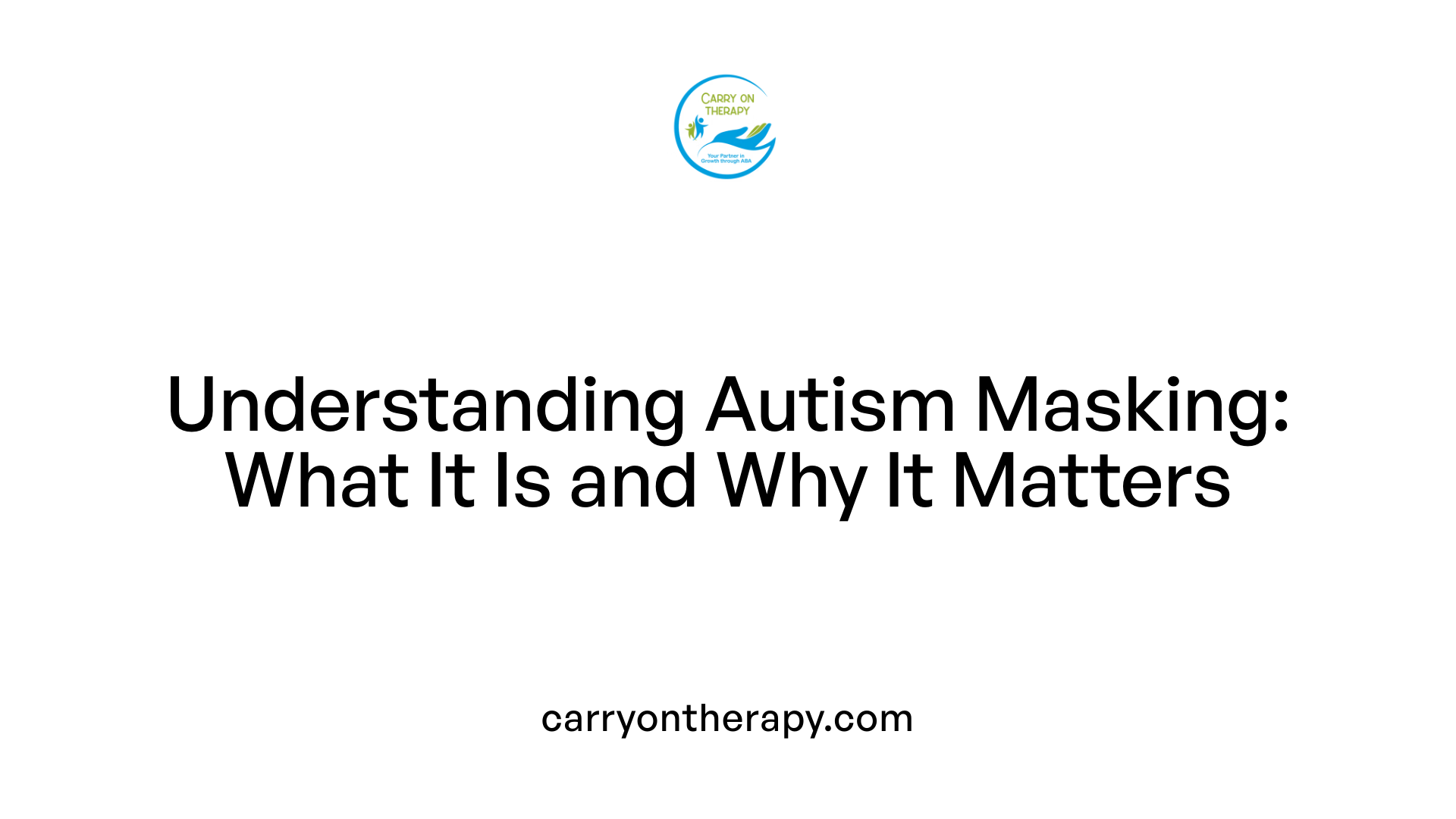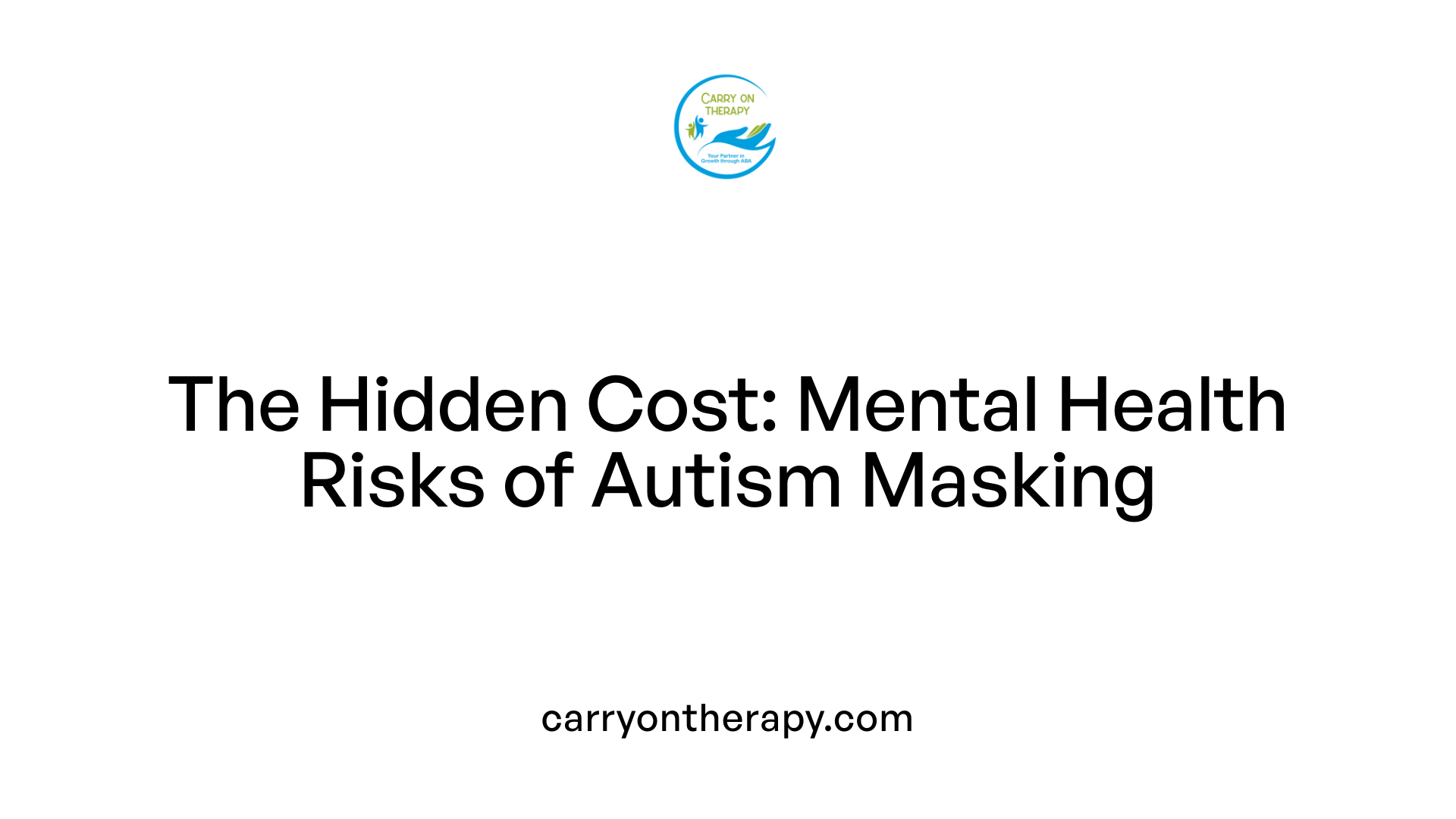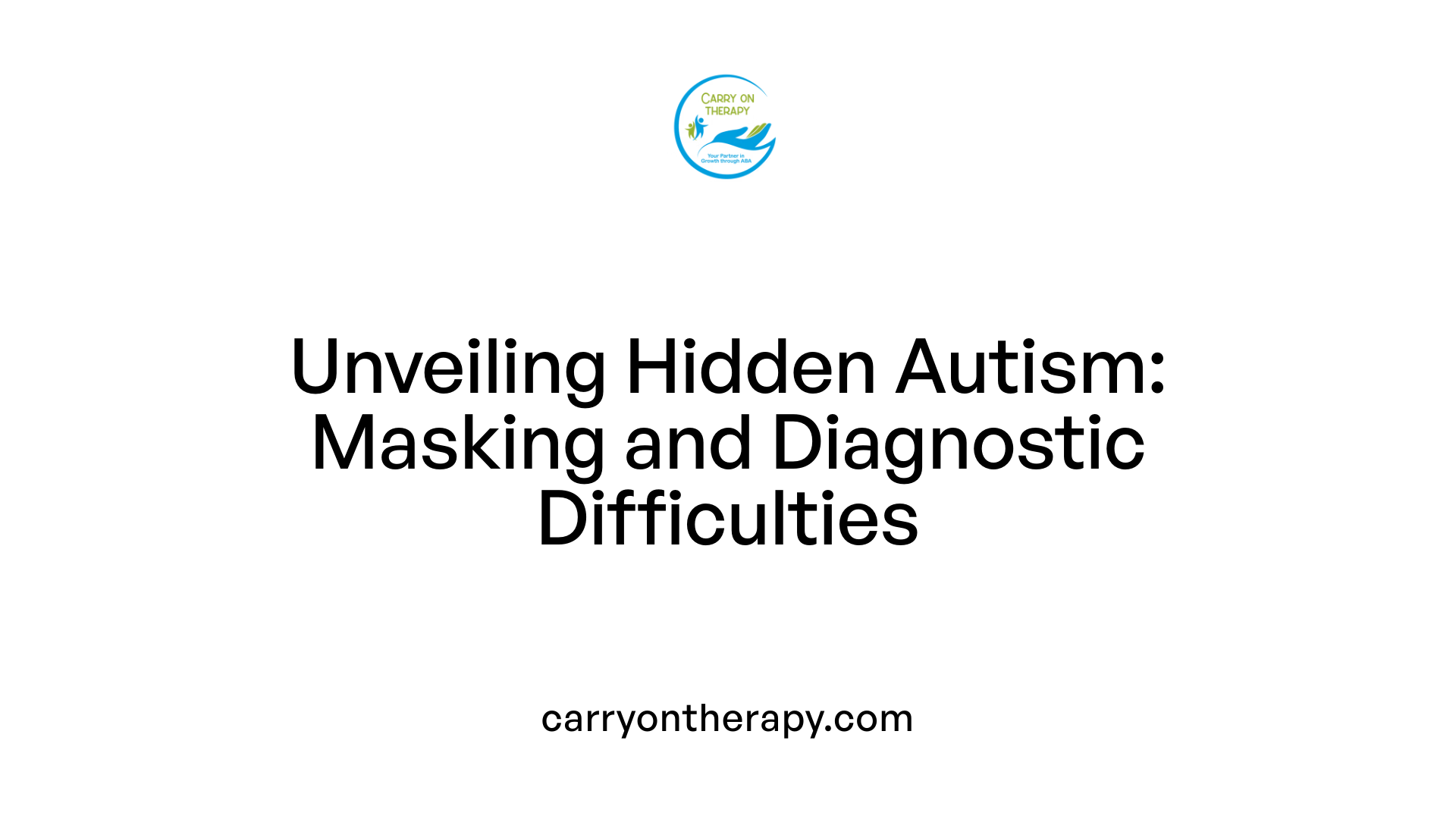Exploring the Hidden Layers of Autism Experience
Autism masking, often an unseen phenomenon, describes the coping strategies autistic individuals employ to blend into neurotypical society. This article delves into what autism masking is, why it is used, its psychological and social consequences, and how contemporary therapies and societal approaches are adapting to better support masked individuals.
Defining Autism Masking: The What and Why

What is autism masking?
Autism masking is a behavior strategy where autistic individuals consciously or unconsciously hide or suppress their autistic traits to appear non-autistic and blend into neurotypical society. Often referred to as camouflaging or compensating, this involves mimicking others' facial expressions, forcing eye contact despite discomfort, rehearsing conversations ahead of time, and restraining natural behaviors like stimming (repetitive movements or sounds).
Common masking behaviors and strategies
Autistic people use various techniques to mask, including:
- Mimicking facial expressions and social cues from others.
- Forcing eye contact even if it causes discomfort.
- Adjusting voice tone and volume to align with social expectations.
- Rehearsing or scripting conversations in advance to manage interactions smoothly.
- Suppressing stimming behaviors that might be seen as unusual or socially unacceptable.
- Planning responses and monitoring behavior constantly to avoid drawing attention.
These strategies require significant mental effort and hyper-vigilance to social norms.
Why do autistic individuals engage in masking?
Masking is primarily motivated by the desire to avoid stigma, discrimination, or bullying. Many autistic individuals mask to attain social acceptance, keep friendships, maintain employment, and feel safe in environments that are not accommodating of autism. Over time, masking often becomes an automatic or subconscious habit, making it difficult for the individual to distinguish between their authentic self and the masked persona. Women, girls, and non-binary individuals, as well as those diagnosed later in life, tend to mask more frequently due to added social pressures and expectations.
While masking can help autistic people navigate social situations, it can also be exhausting and impactful on mental health, underscoring the importance of awareness and support from society to reduce these pressures.
The Psychological Toll: Mental Health Effects of Autism Masking

What are the effects of autism masking on mental health?
Autism masking can exact a profound psychological toll on autistic individuals. By consciously or unconsciously suppressing natural autistic behaviors and mimicking neurotypical norms, many experience significant emotional exhaustion and autistic burnout, a state of mental, physical, and emotional depletion.
How does masking relate to anxiety and depression?
Research shows a strong correlation between high levels of masking and elevated rates of anxiety and depression. The effort to continuously monitor and adapt behavior not only heightens stress but also increases vulnerability to mental health disorders. Those who mask often report greater internal distress, including feelings of social isolation and chronic fatigue.
In what ways does masking affect a person's sense of self?
One of the most profound impacts of masking is the loss of authentic self. Constant camouflaging can lead to fragmentation of identity, where individuals feel disconnected from their true selves. This dissonance contributes to low self-esteem, decreased participation in supportive autistic communities, and experiences of grief over a lost or hidden identity.
What is autistic burnout and how is it connected?
Autistic burnout arises from the sustained cognitive and emotional load of masking. It manifests as overwhelming exhaustion, reduced functioning, and heightened sensitivity to stressors. Burnout not only worsens mental health outcomes but also often leads to decreased social engagement and withdrawal.
Overall, masking generates a heavy mental health burden, underscoring the importance of societal acceptance, understanding, and support that reduce the necessity for these exhausting coping mechanisms.
Masked Autism and Diagnostic Challenges

How does masking affect autism diagnosis and support?
Masking complicates autism diagnosis because it conceals many of the outward signs that clinicians rely on to identify the condition. When autistic traits are camouflaged, the typical behaviors used as diagnostic criteria may not be evident during assessments. This hidden nature of symptoms often leads to inaccurate or delayed diagnoses.
How does masking complicate diagnosis?
Because autistic individuals actively adapt or suppress their natural behaviors to fit social expectations, professionals might miss these efforts. They might see a person who appears neurotypical and not recognize the underlying autism. This is especially true when masking behaviors are subtle or highly sophisticated, which may disguise core features of autism.
Why does masking lead to misdiagnosis and late diagnosis?
Autistic individuals who mask effectively can be mistaken for having other conditions or no condition at all. This misidentification causes delays in receiving appropriate care, counseling, and support. Women, girls, and people diagnosed in adulthood frequently experience late diagnosis because they tend to mask more.
What is the effect of masking on access to support?
The obscured presentation due to masking means that many autistic people struggle to obtain timely and accurate diagnoses, which are critical for accessing specialized interventions and support services. Without proper identification, autistic individuals may not receive accommodations or therapies that could improve their quality of life and mental health.
Masking presents a significant barrier to accurate autism diagnosis and effective support, emphasizing the need for clinicians to consider masking behaviors during evaluations and for continued development of assessment methods that capture masked traits.
Who Masks More? Gender, Age, and Diagnosis Timing

Which groups are more likely to mask autism?
Masking autism is more prevalent among women, girls, and non-binary individuals. These groups often engage in masking behaviors more frequently and effectively compared to others. Social and cultural expectations around behavior, communication, and emotional expression play a significant role in encouraging masking in these populations.
Why does late diagnosis affect masking?
Individuals diagnosed with autism later in life also tend to mask more. Masking can obscure typical signs of autism, which often leads to a delayed or missed diagnosis. As a result, these individuals develop well-practiced strategies to adapt and blend in socially before they are formally recognized as autistic.
What demographic tendencies influence masking?
The intersection of gender and diagnosis timing significantly impacts masking. For example, women and non-binary people may mask to meet societal norms and avoid stigma related to their autistic traits. Late diagnosis can compound the effect, as the person may have spent many years suppressing autistic behaviors, sometimes subconsciously, to navigate social settings.
In sum, masking is particularly common among those who face heightened social pressure to conform, including females, non-binary individuals, and people who receive their autism diagnosis as adolescents or adults. Understanding these demographic trends can help improve diagnosis accuracy and support tailored to reducing the heavy burden of masking.
The Social and Emotional Costs of Masking

What social and emotional challenges are associated with masking?
Masking often results in profound social disconnection. Individuals who mask may feel isolated as their true autistic identity is hidden, making it difficult to form genuine connections with others. This disconnection can lead to feelings of loneliness and exclusion from social groups, especially from the autistic community.
Victimization and the link to trauma are significant concerns. Studies show that high levels of masking correlate with past interpersonal trauma, including experiences of shame, teasing, and emotional or physical abuse. The constant pressure to hide one's natural behaviors in order to avoid stigma may reinforce a cycle of vulnerability and emotional harm.
Identity invalidation is another critical emotional challenge. When autistic traits are masked, external observers might dismiss or invalidate the individual’s true self. This lack of recognition often leaves masked individuals feeling misunderstood and alienated, contributing to lower self-esteem and a diminished sense of authenticity.
Emotional distress linked to masking can be severe and multifaceted. Many autistic people express grief over the loss of their authentic selves due to ongoing suppression of natural behaviors and emotions. This grief can lead to fragmentation of identity, increased anxiety, depression, and feelings of not truly belonging to any community.
In summary, masking carries notable social and emotional costs, including social disconnection, vulnerability to victimization, invalidation of identity, and profound emotional distress marked by grief and loss of authenticity.
Masking Beyond Autism: Shared Neurodivergent and Neurotypical Experiences
Is masking unique to autistic individuals?
Masking is not exclusive to autistic people; it spans across autistic, other neurodivergent, and neurotypical individuals alike. It serves as a coping mechanism to avoid stigma, social rejection, and other negative consequences. This widespread use highlights that masking behaviors are a complex response to social pressures rather than a trait solely tied to autism.
Common elements of masking
Across these groups, shared aspects of masking include mimicking social behaviors, rehearsing conversations, and adjusting tone or body language to blend in socially. Individuals often monitor their behavior carefully and suppress natural responses to meet perceived social expectations. These strategies are usually exhausting and impact mental and physical well-being regardless of neurotype.
Neurotype-specific masking characteristics
Though there is significant overlap, some masking behaviors are particularly characteristic of autistic individuals. For example, autistic people often hide sensory sensitivities, such as covering reactions to noise or suppressing stimming behaviors, which are less prominent in neurotypical or other neurodivergent groups. These distinct behaviors reflect differences in sensory processing and social needs.
In summary, masking is a shared experience influenced heavily by societal stigma and social demands. While many behaviors overlap among neurodivergent and neurotypical people, autistic masking frequently involves sensory-related adaptations. Understanding these nuances is key to supporting all individuals managing social pressures through masking.
Masking as a Trauma Response
Is there a connection between masking and trauma?
Research indicates a significant link between autistic masking and experiences of interpersonal trauma. Many autistic individuals who engage in masking report histories of being shamed or teased for their autistic traits. Such negative social interactions can foster feelings of vulnerability, prompting these individuals to hide or suppress their natural behaviors in order to avoid further stigma or abuse.
Masking often emerges as a protective mechanism, developed to cope with social victimization and prevent additional harm. This coping strategy may involve mimicking neurotypical behaviors, suppressing stimming, or carefully controlling facial expressions and speech to blend in.
Furthermore, some therapies and educational programs, despite good intentions, might unintentionally reinforce the need to mask. By focusing on teaching autistic individuals to conform to neurotypical social norms without validating their authentic identity, these interventions can perpetuate masking behaviors rather than reduce social pressures that provoke them.
Understanding masking as a trauma response highlights the necessity for neurodiversity-affirming approaches that respect autistic identity and reduce reliance on masking. Such frameworks can help mitigate mental health risks associated with masking, including anxiety, depression, and burnout, by promoting acceptance and fostering supportive environments.
Benefits and Protective Factors of Masking
Are there benefits to masking?
Despite the many challenges and mental health risks associated with masking, autistic individuals often perceive some benefits. Masking can increase feelings of safety in social environments by reducing the likelihood of negative reactions or bullying. It also aids in gaining social acceptance, allowing individuals to maintain relationships and function more smoothly in work or school settings.
Autistic people frequently report that masking boosts their confidence, enabling them to navigate social situations that might otherwise be overwhelming or inaccessible.
Social acceptance and safety
Masking strategies such as mimicking facial expressions, forcing eye contact, or adjusting speech tone are often aimed at blending in with neurotypical peers. This camouflage can provide a protective buffer against the stigma, discrimination, or exclusion that many autistic individuals face.
By masking, individuals may avoid mistreatment or social isolation, which promotes a sense of safety and belonging in predominantly neurotypical environments.
Role of autistic community participation
Interestingly, participation in the autistic community itself serves as a meaningful protective factor. Engagement with other autistic individuals is linked to reduced masking behavior, likely because it offers a space where people can express their authentic selves without pressure to camouflage.
This participation supports higher self-esteem and a stronger sense of authenticity, helping to counterbalance some of the negative effects of masking. It offers connection, validation, and shared understanding, which are crucial for mental health and identity affirmation.
Overall, while masking often involves sacrifices related to mental health and identity, it also provides important social and emotional benefits, especially when coupled with supportive autistic communal spaces.
Self-Management and Unmasking Strategies
How can individuals manage or reduce the effects of masking?
Managing the impacts of masking begins with recognizing its toll on mental and physical health. Autistic individuals are encouraged to allow themselves ample time for recovery after social situations that require intense masking. This helps replenish depleted energy and reduces stress.
Energy accounting is another effective strategy, which involves consciously monitoring and budgeting one’s energy throughout the day. By planning activities and rest periods, individuals can avoid burnout and maintain better overall wellbeing.
Seeking diagnosis or increasing self-awareness about one’s autistic traits is crucial. Understanding oneself better can empower individuals to identify when they are masking and to seek appropriate support. Sharing these experiences with others—whether through support groups or trusted social networks—can also alleviate feelings of isolation and provide emotional relief.
For many, gradual unmasking in safe and accepting environments offers a pathway to reconnecting with their authentic selves. This process allows individuals to express their natural behaviors more openly while still feeling secure and supported.
By integrating these approaches, autistic people can reduce the stress and exhaustion caused by masking, fostering improved mental health and stronger self-esteem. Support from society, including acceptance and autism-friendly accommodations, further enhances these self-management strategies and encourages healthier, more genuine social participation.
Societal Role: Acceptance and Autism-Friendly Spaces
How can society support autistic people who mask?
Society plays a crucial role in supporting autistic individuals who engage in masking by fostering a more accepting and understanding environment. One effective way is through education, where the public is informed about autism and the complexities of masking. This education helps debunk myths and reduces stigma, creating room for greater empathy and awareness.
Creating more accepting environments
Accepting environments are those where neurodiversity is respected and valued. This acceptance reduces the pressure on autistic individuals to hide their authentic selves, which can lessen the mental and emotional toll associated with masking. Such environments encourage open dialogue and celebrate differences rather than penalize them.
Educating about autism and masking
Education initiatives can inform people about what masking involves, including its subconscious nature and how it varies from person to person. Awareness campaigns and training for schools, workplaces, and healthcare settings can improve recognition of autistic traits and reduce misunderstandings.
Reducing societal pressures to mask
Reducing stigma and social pressures encourages autistic people to express their true selves without fear of rejection or discrimination. This shift may involve challenging stereotypes, promoting inclusive policies, and encouraging acceptance across all levels of society.
Promoting neurodiversity and accommodations
By promoting neurodiversity—the acceptance of different neurological conditions as normal variations—society helps normalize autistic behaviors and decreases the need for masking. Providing accommodations, such as sensory-friendly spaces, flexible communication options, and respectful social settings, supports autistic individuals' well-being.
Together, these measures can significantly improve mental health outcomes by lessening the need for exhausting masking behaviors, helping autistic people to thrive authentically and comfortably within their communities.
Masking Behaviors: Specific Actions and Signs
What behaviors indicate masking in autistic individuals?
Masking in autistic individuals often involves a range of specific actions aimed at appearing neurotypical and fitting into social settings. One common behavior is forcing eye contact, even when it causes discomfort or anxiety. This action is consciously performed to mirror expected social norms.
Another typical masking behavior is mimicking social cues, such as copying facial expressions, gestures, and speech patterns of others. This imitation helps autistic people blend in and be perceived as "normal" during interpersonal interactions.
Suppressing stimming behaviors is also frequent. Stimming includes repetitive movements or sounds that autistic people use to self-regulate, but these are often hidden or controlled to avoid drawing attention. Additionally, masking may involve dampening sensory responses, like hiding reactions to loud noises or bright lights.
Scripting conversations is another strategy, where individuals rehearse what they plan to say ahead of time to avoid social missteps and reduce anxiety. Speech modifications such as changing tone, volume, and pacing are also common, along with maintaining social distance or adjusting proximity to others in a way that goes against natural comfort levels.
These masking behaviors collectively require significant effort, leading to exhaustion and emotional strain, but they are crucial for many autistic individuals seeking social acceptance or to avoid negative judgment.
Masking Development Over Time and Lifespan Effects
How does masking change over the course of a person's life?
Masking behaviors typically begin in childhood, emerging as individuals with autism learn to observe and imitate social cues to fit in. This learning process involves mimicking facial expressions, scripting conversations, and suppressing natural autistic responses like stimming. Many start masking unconsciously, influenced by social pressures or the desire for acceptance.
As people age, the effort required to maintain masking often increases. Adults may find masking progressively more exhausting and difficult, partly due to cumulative emotional and cognitive strain. This heightened difficulty with age can lead to autistic burnout, a state of intense physical and mental exhaustion.
Long-term masking carries significant impacts on identity and health. Constantly hiding one's authentic self can fragment personal identity, causing feelings of inauthenticity, emotional distress, and social disconnection. Over time, this may contribute to serious mental health concerns such as anxiety, depression, and low self-esteem.
Managing these effects often requires strategies like scheduled recovery time, energy accounting, and creating safe spaces for unmasking. Understanding the developmental trajectory of masking highlights the need for supportive, neurodiversity-affirming environments that reduce the pressure to mask and promote mental well-being throughout the lifespan.
Masking and Autism Spectrum Disorder Diagnosis: Limitations and Considerations
Are there formal tools to assess masking during autism diagnosis?
Currently, no formal clinical tools have been established to directly assess masking in autism diagnosis. However, researchers have developed some questionnaires that aim to measure camouflaging behaviors for research purposes. These instruments help to better understand how autistic individuals may consciously or unconsciously hide or suppress autistic traits during social interactions.
Questionnaires developed for research
Research-focused questionnaires capture different aspects of masking, such as mimicking social behaviors, rehearsal of conversations, suppression of stimming, and managing sensory responses. While informative, these tools are not yet standardized or widely implemented in clinical practice.
Clinical recommendations to consider masking
Healthcare professionals conducting autism assessments are advised to be aware of masking as a significant factor that can obscure traditional diagnostic signs. Since masking can vary widely between individuals and may be subconscious, considering behavioral adaptations and histories of social camouflaging is crucial.
Impact on diagnostic practice
Masking complicates diagnosis by often leading to missed or delayed identification of autism, especially in populations more prone to camouflage, such as women, girls, and non-binary individuals. This invisibility can result in inadequate support and misunderstanding of autistic needs. Awareness of masking's impact encourages clinicians to employ more nuanced assessment approaches, including thorough developmental histories and collateral information from multiple sources.
This evolving understanding highlights the urgency for developing formal assessment tools and training clinicians to recognize masking behaviors, ultimately improving timely and accurate autism diagnosis.
Impact of Masking on Identity and Community Participation
How does masking affect autistic people's identity and community life?
Masking significantly influences autistic individuals' sense of self and their engagement with the autistic community. It often results in a reduced sense of authenticity, where individuals feel disconnected from their true identity. This internal conflict can lead to lower self-esteem and a fragmented self-concept, as people may suppress essential parts of who they are to fit societal expectations.
Reduced authenticity tends to discourage involvement in the autistic community, as those who mask may not feel comfortable or accepted in spaces that celebrate neurodiversity openly. This decreased participation can deprive autistic individuals of valuable social support and affirmation, which are important protective factors against mental health challenges.
The loss of connection with their autistic identity caused by consistent masking can exacerbate feelings of isolation, emotional distress, and contribute to worsening mental health outcomes. By masking, autistic people may inadvertently distance themselves from a community that offers understanding, acceptance, and validation, which are crucial for fostering self-esteem and resilience.
Understanding these effects stresses the importance of promoting environments that encourage openness and acceptance of autistic traits to strengthen community ties and support authentic expression.
Therapeutic Approaches: Rethinking Masking in Autism Interventions
How do current therapies view masking, and what changes are advocated?
Traditional autism therapies have often included teaching masking or camouflaging strategies as a way to help autistic individuals fit into neurotypical social environments. These techniques typically focus on skills like mimicking facial expressions, rehearsing social conversations, and suppressing natural autistic behaviors.
However, recent research and advocacy argue against this approach. Critics highlight that teaching masking strategies can reinforce trauma-related responses and exacerbate mental health challenges such as anxiety, depression, and burnout. Masking is seen not merely as a skill but as a survival strategy that carries significant emotional and cognitive costs.
Advocacy for neurodiversity-affirming approaches
There is a growing movement supporting therapies that affirm neurodiversity—recognizing and respecting autistic traits rather than attempting to suppress them. These approaches prioritize acceptance, self-understanding, and identity affirmation. Instead of encouraging individuals to mask, they aim to create supportive environments that reduce social pressures to conform and decrease the need for camouflaging.
Therapies informed by neurodiversity principles emphasize fostering authentic self-expression and mental well-being. They also focus on helping autistic individuals manage sensory sensitivities, advocate for accommodations, and develop self-acceptance.
Focus on identity affirmation and acceptance
A critical shift in therapeutic practice involves centering autistic identity and encouraging self-awareness. Rather than viewing masking as a necessary skill, therapists aim to help clients explore safe and gradual unmasking when appropriate. This fosters a stronger connection to their authentic selves and helps mitigate the emotional exhaustion and loss of identity that masking can produce.
Overall, the reevaluation of masking within autism interventions reflects a broader societal push toward inclusion and respect for neurodivergent experiences, supporting autistic individuals not by making them blend in but by valuing their unique perspectives and needs.
Applied Behavior Analysis (ABA) Therapy: A Common Autism Intervention
What is Applied Behavior Analysis (ABA) therapy and how is it used to support individuals with autism?
Applied Behavior Analysis (ABA) therapy is a scientifically grounded method widely used to support individuals with autism spectrum disorder (ASD). ABA focuses on understanding and modifying behavior through carefully designed interventions that encourage positive behaviors and reduce potentially harmful ones.
Overview of ABA therapy principles
ABA operates on the principle that behavior is influenced by its consequences. By identifying the functions of specific actions, therapists can apply strategies to reinforce desirable behaviors, like improving communication and social interactions, while decreasing behaviors that may be harmful or interfere with learning and daily life.
Use of positive reinforcement and behavior modification
A central technique in ABA is positive reinforcement, where preferred responses or achievements are rewarded to increase their future occurrence. This might involve praise, tokens, or other incentives. Behavior modification also uses prompting and shaping, guiding individuals in learning new skills step-by-step.
Tailoring to individuals' needs
ABA interventions are highly individualized. Qualified professionals start with a comprehensive assessment of the person’s abilities, challenges, and goals to design personalized programs. Adjustments are continuously made based on progress and changing needs, ensuring that therapy supports personal growth in the most effective way.
Overall, ABA therapy offers a structured and measurable approach to help autistic individuals develop necessary skills and improve their quality of life through consistent, positive, and supportive methods.
Providers of ABA Therapy for Autism
Who provides ABA therapy for individuals with autism?
ABA therapy is delivered by trained and certified professionals, including Board Certified Behavior Analysts (BCBAs), Board Certified assistant Behavior Analysts (BCaBAs), and qualified behavior technicians. These experts have received specialized education and certification to design, supervise, and implement behavior analytic interventions tailored to the needs of individuals with autism.
Role of BCBAs, BCaBAs, and Technicians
- BCBAs oversee assessment and treatment planning, ensuring therapy is personalized and effective.
- BCaBAs assist BCBAs in implementing interventions and may conduct some direct therapy under supervision.
- Behavior Technicians work closely with clients, providing one-on-one therapy sessions following BCBA plans.
Organizations Offering ABA Services
ABA services are provided by a variety of organizations ranging from specialized clinics and private practices to companies like Autism Behavior Services. These providers deliver therapy in multiple settings, including:
- Client homes
- Educational environments such as schools
- Clinical or outpatient centers
- Telehealth platforms, enhancing access especially in underserved areas.
Insurance Coverage and Settings
Many insurance programs, including Medi-Cal, offer coverage for ABA therapy, reducing financial barriers for families seeking this intervention. Services covered may span in-person sessions and telehealth visits. Therapy settings are chosen based on client needs and may be flexible to support generalization of skills across environments.
The comprehensive delivery of ABA therapy by certified professionals across varied settings and supported by insurance facilitates access to essential services that improve outcomes for autistic individuals.
Goals and Structure of ABA Therapy
What are the main goals of ABA therapy in autism treatment?
ABA (Applied Behavior Analysis) therapy aims to develop functional and social skills essential for everyday life. It focuses on improving communication abilities, fostering independence, and reducing challenging behaviors through tailored interventions. The therapy emphasizes positive reinforcement to encourage desirable behaviors, ensuring progress reflects individual needs. These goals are pursued across various environments, including home, school, and community, to support comprehensive development.
How is ABA therapy typically structured?
ABA therapy is organized around individualized treatment plans with specific, measurable objectives. Trained therapists employ systematic techniques such as breaking down complex skills into manageable steps and applying consistent reinforcement. Sessions are carefully designed to engage the child’s interests, enhancing motivation and participation.
Data collection plays a crucial role in ABA, as therapists continuously monitor progress to make informed adjustments to the treatment plan. Collaboration with parents and caregivers is essential, promoting skill generalization beyond the therapy setting and ensuring consistent support in everyday situations. This partnership fosters a collaborative environment to maximize treatment benefits and address family concerns effectively.
Evaluating ABA’s Effectiveness in Autism Intervention
What evidence supports the effectiveness of ABA therapy for autism?
Applied Behavior Analysis (ABA) therapy is backed by extensive research, including numerous randomized controlled trials. These studies consistently show that ABA can lead to meaningful improvements in social communication, language development, and cognitive skills among autistic individuals. The outcomes are particularly positive when therapy begins early in life and is delivered intensively.
Improvements in language, socialization, and cognition
ABA interventions focus on teaching skills systematically and reinforcing desired behaviors. This method has proven effective in enhancing foundational abilities like speech and conversational skills, which contribute to better socialization. Cognitive improvements are also observed as children learn to understand and respond to their environment more effectively.
Importance of early and intensive therapy
Research highlights that early diagnosis and prompt intervention through ABA maximize benefits. Intensive programs, often involving several hours per week, allow for practice and skill generalization across various settings. Early and sustained therapy supports long-term developmental gains.
Shift toward naturalistic and individualized methods
Modern ABA approaches have evolved to emphasize naturalistic, play-based strategies rather than rigid drills. These methods respect individual differences and prioritize incorporating a child's interests, which helps maintain motivation and fosters skill generalization. The focus is on personalizing therapy to support authentic development rather than mere behavioral compliance.
Masking and Therapy: Potential Conflicts and Opportunities
How Masking Behaviors Influence Therapy Needs
Masking in autistic individuals significantly shapes the kind of therapeutic support they require. Since masking often involves suppressing natural behaviors—like stimming—or rehearsing social interactions, therapies need to address not only surface behaviors but also the underlying emotional and cognitive strain. Individuals who mask frequently experience anxiety, depression, and burnout, signaling a need for interventions that relieve these burdens rather than just modify outward behavior.
Risks of Therapies Encouraging Masking
Certain therapeutic methods risk reinforcing masking by training autistic individuals to adopt neurotypical behaviors without validating their authentic autistic identity. Such approaches can unintentionally increase mental health struggles, as masking contributes to exhaustion, stress, and identity fragmentation. There is concern that therapies promoting masking may exacerbate stigma and perpetuate the pressure to conform, leading to delayed diagnosis or unmet emotional needs.
Theme of Identity Affirmation in Interventions
Modern perspectives emphasize identity-affirming therapies that honor autistic traits rather than suppress them. Interventions focused on self-awareness, acceptance, and empowerment help reduce the compulsion to mask. By cultivating environments that celebrate neurodiversity, therapies can promote improved self-esteem and authentic engagement with others, mitigating the negative mental health impacts linked to habitual masking.
Integration of Therapies Addressing Masking Effects
Effective therapy approaches integrate brain-based (such as neurofeedback and neurostimulation) and psychological strategies focused on sensory management, emotional regulation, and energy conservation. These multi-modal treatments support autistic individuals in reducing the cognitive effort required for masking, managing anxiety, and preventing burnout. Importantly, gradual unmasking in safe, supportive settings is encouraged to foster identity restoration and social confidence.
Through evolving therapeutic practices, there is an opportunity to transform masking from a source of distress into a less taxing strategy, while prioritizing genuine self-expression and mental well-being.
Innovative Therapies Supporting Neurodiversity and Sensory Regulation
Brain Map-Guided Neurofeedback
Brain map-guided neurofeedback is an emerging therapy designed to support neurological function by identifying dysregulated brain regions through quantitative EEG (qEEG) brain mapping. This technique helps clinicians pinpoint specific areas linked to autism symptoms.
Neurostimulation Methods
Neurostimulation complements neurofeedback by directly targeting brain areas to modulate neural activity, aiming to improve cognitive processes and reduce symptoms associated with autism. These methods are being refined to enhance overall brain function safely and effectively.
Focus on Symptom Reduction and Neurological Function
Together, neurofeedback and neurostimulation therapies target symptom reduction by training the brain to regulate itself better. While they do not cure autism, these treatments can lessen challenges such as sensory processing difficulties, anxiety, and social communication barriers, contributing to improved daily functioning.
Complementary Role Alongside Behavioral Therapies
These neurological therapies form part of a broader behavioral therapy approach. They are used in conjunction with personalized interventions that focus on managing sensory sensitivities, promoting identity affirmation, and equipping individuals with strategies to navigate social situations comfortably.
The integration of brain-based therapies represents a promising advancement for autistic individuals seeking support tailored to their neurodiverse profiles and sensory regulation needs. Such holistic treatment approaches aim to empower self-understanding and enhance quality of life without pressuring individuals to mask or camouflage their authentic selves.
The Path Forward: Reducing Masking Through Social Change and Support
Importance of Early Diagnosis and Awareness
Early and accurate diagnosis of autism is crucial in minimizing the need for masking. Without recognition of autistic traits, individuals often engage in extensive masking, leading to exhaustion and delayed access to support. Increased awareness among healthcare professionals and the public can help identify autism sooner, fostering environments where autistic individuals feel safer to express themselves authentically.
Creating Supportive Environments
Supportive environments are vital in reducing pressures to mask. This includes autism-friendly social spaces that accommodate sensory sensitivities and respect different social communication styles. When autistic people are accepted and understood without judgment, the need to camouflage behavior to avoid stigma diminishes, improving mental health outcomes and reducing social isolation.
Education and Policy Change for Neurodiversity
Education systems and workplaces must integrate neurodiversity-affirming policies. Incorporating training on autism and masking into professional development promotes acceptance, reduces discrimination, and addresses harmful practices that encourage masking. Policy changes can mandate accommodations and create safe spaces, allowing autistic individuals to participate fully without sacrificing their identity.
Community Involvement to Promote Authentic Self-Expression
Participation in autistic and neurodivergent communities serves as a protective factor against masking. These communities foster authenticity, self-esteem, and shared understanding. Encouraging connection and peer support empowers autistic individuals to explore unmasking gradually and safely, easing the emotional burden of masking and reinforcing their true identities.
Embracing Authenticity: Moving Beyond Masking
Autism masking reveals a complex interplay between individual survival strategies and societal expectations. While masking can protect autistic people from stigma and harm, it often exacts a heavy toll on mental health and identity. Recognizing masking’s presence and implications is crucial for improving diagnosis, therapy, and support. Effective autism interventions, including ABA therapy, must balance skill development with respect for individuality and neurodiversity. Ultimately, fostering acceptance, understanding, and autism-friendly environments will reduce the need to mask and empower autistic individuals to live authentically and thrive.
References
- Masking
- Autistic Masking in Relation to Mental Health, Interpersonal ...
- Experiences of Masking in Autistic and Nonautistic Adults
- “Masking” in Individuals with Autism Spectrum Disorder
- Understanding High Masking Autism
- What Are Autism Masking Behaviors? Symptoms, Effects & ...
- Understanding Autism Masking and Its Consequences
- ABA Clinics/Behavior Specialist for Toddlers in Los Angeles
- Applied Behavior Analysis (ABA)
You have to Start to be Great!






